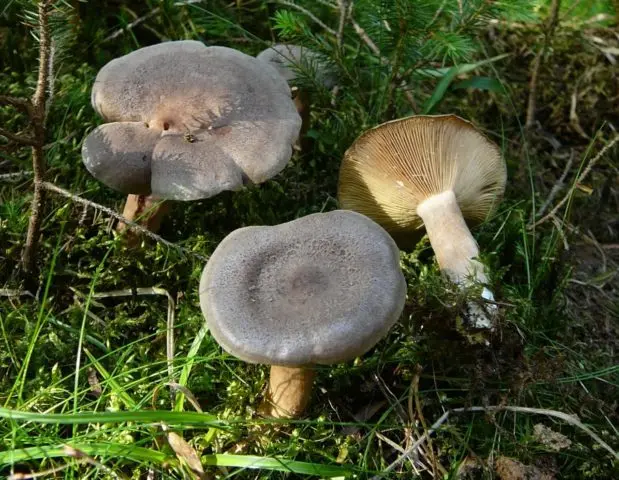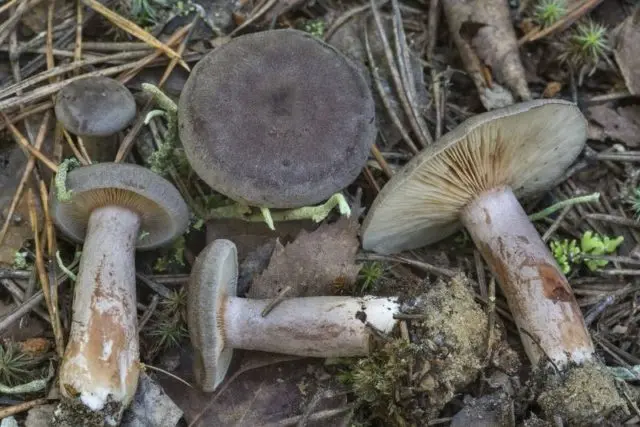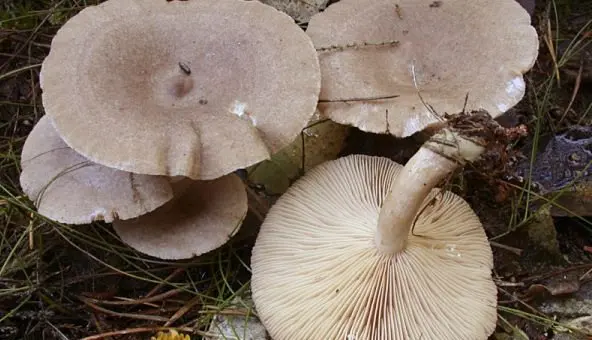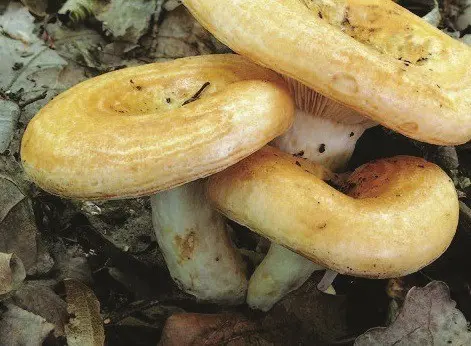Contents
Papillary breast (milk papillary, large breast, Lactarius mammósus) – agaric fungus of the genus Mlechnikov, family Russula, is conditionally edible due to the content of milky juice, which gives the fruiting bodies a bitter taste. This type, like other edible varieties of milkers, is very popular in traditional cuisine.
Description of the papillary breast
Papillary mushroom is a fairly large agaric fungus on a stalk. Many fans of “quiet hunting” believe that he has an ordinary appearance, but his hat can have a beautiful color due to the presence of unusual shades in it.
The papillary breast belongs to the milkers. Its milky juice is not abundant, it tastes sweet, but leaves a bitter aftertaste. Does not change color in air. In old overripe individuals, it is practically absent.

Cap Description
The cap of the papillary milk mushroom has a different thickness: in some areas it is thin, in others it is fleshy. Its diameter is 30–90 mm. In young specimens, the edges of the cap are bent, but over time it acquires a prostrate flat or curved shape with a pronounced tubercle in the center.
The papillary breast has a gray hat with shades of other colors: blue, brown, purple, brown or even pink. With age, the hat fades, becomes dry and turns yellow. Mushroom fibers and scales are visible on the hat of adults. The flesh is white, darkens when the skin is removed.
The plates are frequent, narrow, whitish in color, reddening over time.

Description of the leg
The leg of the papillary breast is cylindrical, smooth, white in young representatives, has a length of 30–70 mm, a thickness of 8–20 mm. With age, it becomes hollow, darkens and takes on the color of the cap. The dense brittle flesh of the leg is odorless, has a sweetish aftertaste.

Where and how to grow
The fruiting period of the papillary mushroom is short – usually the season falls on August-September, but depending on weather and climatic conditions, this period may be longer. It always grows in groups, single specimens are almost never found. It can be found in coniferous, deciduous and mixed forests on sandy soils or acidic moist soils. Grows in northern temperate regions. Most milkers of this species are collected in Siberia, the Urals and the Central region of Our Country.
Is the mushroom edible or not?
The fungus of this species is classified as conditionally edible.
How to prepare papillary milk mushrooms
To get rid of the bitter taste, milk mushrooms are soaked for three days in water, changing the water twice a day. The most popular are salted or pickled milk mushrooms. There is evidence that in Our Country the salted milk mushroom was even called the “royal mushroom”. After soaking, it can be cooked in any other way: add to soups, fry, stew, etc.
Medicinal properties of papillary mushrooms
In folk medicine, milk mushrooms have long been used to treat diseases of the kidneys and liver and as a diuretic. It is noticed that their use significantly reduces the likelihood of salt deposition and the formation of stones. Modern research shows that the composition of the pulp of mushrooms includes a substance with antibacterial properties, so this fungus is used in medicine as an adjuvant in the treatment of tuberculosis and other lung diseases. It is also used to speed up wound healing.
As an anti-inflammatory agent, salted papillary milk mushrooms show the greatest effectiveness. For the treatment of various kinds of inflammation, they are eaten every 3 days, 250 g each. Regular consumption of this type of lactic acid helps strengthen immunity.
Due to the high content of B vitamins, these mushrooms are used in the treatment of mental disorders. They are part of drugs to strengthen the nervous system and prevent neuroses and depressive states.
Used in cosmetics
Papillary milk mushrooms are a unique product that has found application even in cosmetology. Vitamin D, which is part of it, has a beneficial effect on the condition of the skin and hair. It is found in animal products and produced by exposure to the sun, but if for some reason these sources are not available, milk mushrooms are quite capable of filling the deficiency of this essential vitamin.
In cosmetology, decoctions and extracts from fruiting bodies are also used. Due to their bactericidal properties, they strengthen the hair and cleanse the skin when applied externally.
Among the people, mushrooms of this species are often used to remove warts. To do this, a cap of salted mushrooms is applied to the growth and left for some time to act. The procedure is repeated until the result is achieved.
The benefits of papillary mushrooms for weight loss
The protein of these mushrooms is not inferior in nutritional value to protein of animal origin, so milk mushrooms are an excellent source of this essential substance for those who do not eat meat. The product itself is quite high-calorie, but the protein practically does not form body fat, but it allows you to achieve rapid saturation. Its value lies in the fact that it provides energy without fats and carbohydrates. The main element of the fruiting body is fiber, which is necessary for proper digestion.
The amino acids that make up these lactic acid are well absorbed by the body, and vitamins A, E, PP, ascorbic acid and minerals allow you to get the necessary trace elements in sufficient quantities, which is very important for dietary nutrition. The diuretic effect is to remove excess fluid and toxins from the body.
Twins and their differences
The most dangerous twin of this type of fungus is the false papillary milkweed (camphor milkweed), which, although conditionally edible, can cause serious poisoning. With age, it accumulates a substance that does not decompose during heat treatment and is dangerous for the body in large quantities, so experts recommend refusing to collect it.
In order not to confuse camphor lactic with more valuable milk mushrooms, pay attention to the following signs:
- young false milk mushrooms have a pronounced smell of camphor, but with age, their flesh also acquires the aroma of coconut, so this feature cannot be considered absolute;
- the color of the cap of the inedible twin is dark brown, with purple hues, however, if the mushroom grows on the edges of the sun, its cap may fade and acquire a light brown tint;
- the pulp of the camphor lactic leg is reddish;
- the most reliable sign of a false double is the appearance of a dark brown spot when pressed on the cap, which immediately turns into an ocher color.

It looks like a papillary breast and a conditionally edible lactic fragrant. You can distinguish it by the hat: in the twin, it is slightly pubescent, and its shade is lighter – ocher-gray or lilac-gray. The center of the cap, as a rule, without a tubercle is somewhat depressed. Grows in deciduous and mixed forests under birches. The fresh pulp of the fragrant milkweed has a pronounced smell of coconut.

Oak breast is another species similar to papillary. It also belongs to the conditionally edible representatives of the mushroom kingdom. Its red or orange-yellow cap is funnel-shaped and turned inward at the edges. Oak milk mushrooms form mycorrhiza with beech, oak, hornbeam.

Conclusion
The papillary mushroom is a mushroom well known to experienced lovers of “silent hunting”. The unique chemical composition makes it not only a valuable food product, but also determines its medicinal, dietary and cosmetic properties.









